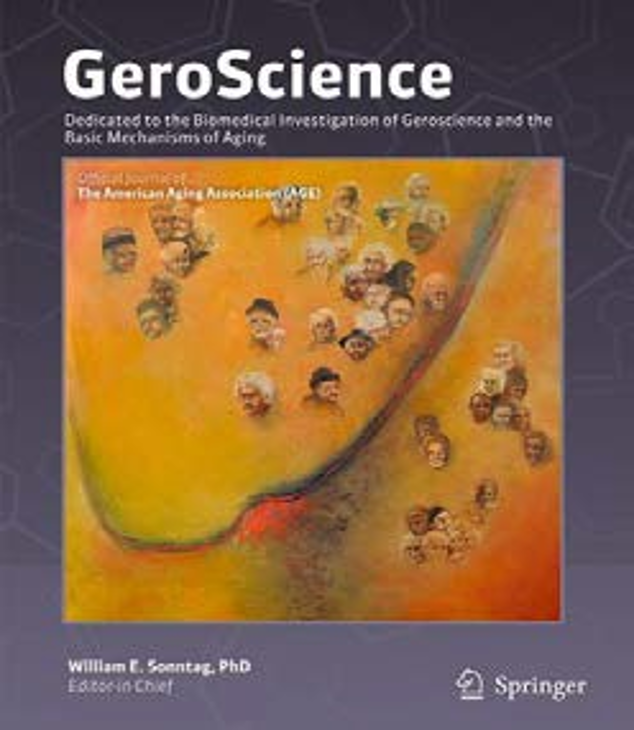JournalAGE Members have free access rights to the electronic content of the journal GeroScience. Only AGE members in good standing are entitled to get full free access to this journal and its articles. **To access the journal you must be logged in to your account and use the "Journal Access" dropdown in the menu bar above. Follow GeroScience on Social Media!
Announcement of the 2025 GeroScience Outstanding Publication AwardsSimilar to the previous year, we are delighted to announce the 2025 GeroScience Outstanding Publication Awards, a prestigious initiative designed to celebrate and honor outstanding original research papers and reviews in the field of aging. These awards consist of six categories, each aimed at recognizing excellence in GeroScience publications: Outstanding Original Research Paper Award – First Prize: $2000 Outstanding Original Research Paper Award – Second Prize: $1500 Outstanding Original Research Paper Award – Third Prize: $1000 Outstanding Original Research Paper Award – Fourth Prize: $500 Outstanding Review Paper Award – First Prize: $1000 Outstanding Review Paper Award – Second Prize: $500 These awards will be presented annually during the meeting of the American Aging Association (AGE). At this event, the first author(s) of the winning papers will be awarded a monetary prize, while all author(s) will be recognized with certificates or plaques. We enthusiastically encourage all eligible authors to actively participate in the AGE meeting, which you can find more information about here: https://www.americanagingassociation.org/annual-meeting. Eligibility and Submission Process:To be eligible for the "GeroScience Outstanding Publication Awards," original research papers and reviews must have been published in GeroScience (the official journal of the American Aging Association) during the preceding three years, up to March 1 before the AGE meeting in the current year. Authors wishing to be considered for these awards must submit an application that includes the research paper and a curriculum vitae (CV) as a combined PDF file to Assistant Editor Zsuzsanna Tucsek, PhD (email: [email protected]). Trainees are encouraged to include a support letter from the last/corresponding author to enhance their application. The submission deadline for the 2025 awards is March 15, 2025 Award selection:The selection of awardees will be carried out by an impartial Outstanding Publication Award Committee. This committee comprises five Editors delegated by the Editor-in-Chiefs, the Editor-in-Chiefs themselves, and Deputy Editors. To ensure a comprehensive and equitable evaluation process, the committee will consider both quantitative and qualitative assessments. Quantitatively, the Field Weighted Citation Index (FWCI), published by Elsevier/Scopus, will be used to objectively assess the scientific impact of eligible papers. Qualitative factors, such as the significance of the research, will also be taken into account. This balanced approach guarantees the recognition of the best contributions to GeroScience. GeroScience: A Premier Interdisciplinary Aging Research JournalGeroScience has achieved the status of a Q1/D1 journal in Scopus, reflecting its prominence and influence. Key metrics, such as the CiteScore index of 10.5 based on Scopus citation data and an impact factor of 5.3 based on Clarivate/Web of Science citation data, place GeroScience alongside the most influential aging research journals. We welcome manuscripts that cover the entire spectrum of Geroscience, ranging from basic science, translational and clinical research, to epidemiology and public health interventions, all centered around aging research. Aims and scope: https://www.springer.com/journal/11357/aims-and-scope Our journal's editorial board consists of internationally recognized leaders in their respective fields, representing the focus areas of the journal and ensuring that the highest quality research is published in the journal. We eagerly anticipate receiving your outstanding contributions and strongly encourage you to submit your very best research to GeroScience! We look forward to celebrating the remarkable achievements in GeroScience. Sincerely, Zoltan Ungvari, MD, PhD
We are excited to announce the winners and honorable mentions of the 2024 GeroScience publication awards! Join us in celebrating their outstanding contributions to the field of aging research. Congratulations to all the recipients! 2024 GeroScience Outstanding Publication Award WinnersOutstanding Original Research Paper AwardFIRST PRIZE - Balázs Győrffy, Head of the Department of Bioinformatics at Semmelweis University, Budapest, Hungary. Discovery and ranking of the most robust prognostic biomarkers in serous ovarian cancer | GeroScience (springer.com) SECOND PRIZE - Steve Horvath, Principal Investigator at Altos Labs, California, USA; Harold Katcher, Co-Founder & Chief Executive Officer and Akshay Sanghavi, Co-Founder & Chief Executive Officer at Yuvan Research Inc., Mountain View, California, USA. Reversal of biological age in multiple rat organs by young porcine plasma fraction | GeroScience (springer.com) THIRD PRIZE - Lin Yi, Founder and CEO ofAbinopharm, Inc., Connecticut, USA. The efficacy and safety of β-nicotinamide mononucleotide (NMN) supplementation in healthy middle-aged adults: a randomized, multicenter, double-blind, placebo-controlled, parallel-group, dose-dependent clinical trial | GeroScience (springer.com) FOURTH PRIZE - Emily E. Bray, Assistant Professor at University of Arizona and Research Scientist at Canine Companions for Independence. Associations between physical activity and cognitive dysfunction in older companion dogs: results from the Dog Aging Project | GeroScience (springer.com)
Outstanding Review Paper AwardFIRST PRIZE - Ramasamy Selvarani, PhD Doctoral Candidateand Sabira Mohammed Jazir, Post-Doctoral Research Fellow at The University of Oklahoma Health Sciences Center, under the mentorship of Dr. Arlan Richardson. Effect of rapamycin on aging and age-related diseases—past and future | GeroScience (springer.com) SECOND PRIZE - Jorge Quarleri, Principal Researcher and Adjunct Professor at the Institute for Biomedical Research on Retroviruses and AIDS, Argentina. Monkeypox: considerations for the understanding and containment of the current outbreak in non-endemic countries | GeroScience (springer.com)
2024 GeroScience Outstanding Publication Award
|

